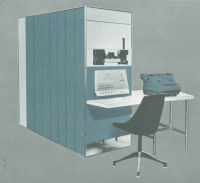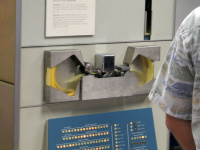Driver:pdp1: Difference between revisions
(PaperTape FTW!) |
No edit summary |
||
| Line 30: | Line 30: | ||
But you want to do something with the device, so first you will need some software - in 1951 though there were no magnetic disks available so the only media we have is paper. So called Paper Tape [[File:PDP-1_loading_a_program_from_the_paper_tape_(2283393712).jpg|200px|right| Loading from Paper Tape]] | But you want to do something with the device, so first you will need some software - in 1951 though there were no magnetic disks available so the only media we have is paper. So called Paper Tape [[File:PDP-1_loading_a_program_from_the_paper_tape_(2283393712).jpg|200px|right| Loading from Paper Tape]] | ||
Since it is a very low probability that you got a real papertape reader, or even one that can be connected to a modern PC here will link you my Archive of currently available Papertapes as a digital archive for MAME (simply place it in a rompath diredtory referenced in mame.ini) [[Media:pdp1_ptp.7z|PDP1 Softwarelist Archive (7z)]] | |||
Revision as of 22:54, 18 February 2023
DEC PDP-1
This device shows what MAME is really about - the preservation of technology for the generations to come.
Short Summary about the Hardware
Short Excerp from the PDP-1 Restoration project::

The launch of Digital Equipment Corporation’s PDP-1 (Programmed Data Processor-1) computer in 1959 marked a radical shift in the philosophy of computer design.
Though the PDP-1 was produced in relatively small quantities (about 50), its impact was significant. For DEC it was the first in a long line of computers that focused on interactivity and affordability, changing the industry forever by foreshadowing what would become an entirely new class of computer: the “minicomputer.” By the mid 1960s, the minicomputer industry would flourish, allowing more people access to computers than ever before and leading directly to the development of important new operating systems and interfaces.
As the world's first commercial interactive computer, the PDP-1 was also used for process control, scientific research and graphics applications as well as to pioneer timesharing systems. The PDP-1 also made it possible for smaller businesses and laboratories to have access to much more computing power than ever before.
For the user, the PDP-1 represented an unprecedented freedom of human-machine interaction, spurring the creation of hacker culture at the Massachusetts Institute of Technology (MIT), Bolt Beranek and Newman (BB&N) and elsewhere. Inspired programmers would soon create early debugging, text editing, music and game programs, including the first computer video game, Spacewar!
continnue reading on Restoration Project Introductory Page
How to run PDP-1 in Mame
To emulate the pdp-1 you can start mame with
mame pdp1
Opposiite to many other later devices, the PDP-1 did not contain any software that could be loaded as a Firmware.
But you want to do something with the device, so first you will need some software - in 1951 though there were no magnetic disks available so the only media we have is paper. So called Paper Tape

Since it is a very low probability that you got a real papertape reader, or even one that can be connected to a modern PC here will link you my Archive of currently available Papertapes as a digital archive for MAME (simply place it in a rompath diredtory referenced in mame.ini) PDP1 Softwarelist Archive (7z)